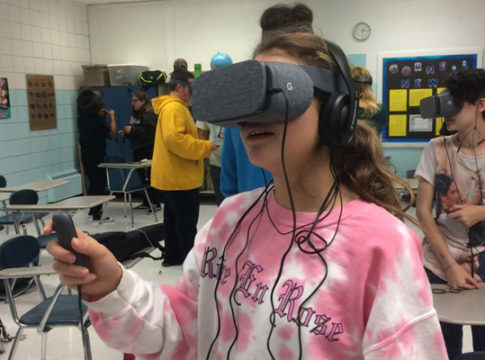Picture this: A student wears a set of goggles that transport her from a classroom in Athens, Georgia, to the Parthenon, 5,600 miles away in Athens, Greece. In an interactive, 3-D world, she peers up and down each of the 17 columns on the temple’s side and examines the fluted shafts. She notes that they have no bases. It’s easy to understand the differences between Ionic and Doric architecture here: rather than relying on textbook descriptions, those differences come to life before her eyes.
 The technology exists to make this scene a reality in classrooms across America. And the conditions appear ripe, as well, which is fueling the latest round of eager speculation about virtual reality’s readiness to break through to the educational mainstream.
The technology exists to make this scene a reality in classrooms across America. And the conditions appear ripe, as well, which is fueling the latest round of eager speculation about virtual reality’s readiness to break through to the educational mainstream.
The question is whether we should believe the hype.
More Broadband, More Investment
First, schools are upgrading their Internet connectivity, which is setting the stage for broadband-dependent virtual-reality learning. The federal ConnectED initiative aims to bring broadband to 99 percent of all U.S. schools by 2018, and progress has been swift. As of last year, 77 percent of schools had access, and the FCC has signed on to spend up to $3.9 billion annually to close the gap.
Second, companies are bringing new devices to market that can provide immersive educational experiences at affordable prices. And an increasing number of providers are entering the market to offer virtual reality experiences.
In March 2014, Facebook paid $2 billion to acquire Oculus VR, a startup that offers a virtual-reality headset called the Oculus Rift. At the time, Oculus claimed its big breakthrough would be in producing a device that cost only $350—the product actually costs $600—yet would provide a 3-D, video-based experience with gyroscopes and motion sensors that would be comparable to devices that cost in excess of $10,000. Soon after, Education Week published a glowing report, quoting a teacher in Western Australia about his “awesome” experience using Oculus devices to serve special-needs students with “meditative or relaxation-oriented virtual-reality apps, such as Titans of Space, a short guided tour of planets and stars.”
In classic disruptive fashion, in September 2015 Google followed the Oculus announcement by launching Google Expeditions at a group of schools. The product consists of a cardboard viewer that costs $15, which holds a smartphone and allows students access to more than 100 virtual field trips.
The Google Cardboard viewer works with elegant simplicity. Users place their smartphone into the viewer, which houses a pair of 45mm focal-distance lenses placed an optimal distance away from the phone’s screen. With compatible apps—such as the New York Times’ virtual-reality app—the lenses create a 3-D effect, and scenes shift with users’ movements. In January, Google launched a beta app for its Android phones that allows students to use viewers to explore historical sites with their own smartphone and tablet.
Further disruption appears imminent: Raw materials and designs are for sale to enable users to create their own inexpensive viewers. And affordable copycat cardboard and plastic viewers are also on the market. The higher-end Rift is mainly associated with immersive gaming for now, despite rumors that the company may consider giving Rift viewers to schools for free.
From Tech Toys to Teaching Tools
In February, the Wall Street Journal took the hype one step further, with a headline proclaiming, “Virtual Reality Learns How to Get Into the Classroom.” The article profiled the moves that one education startup, Nearpod, is making to launch virtual-reality lessons that allow students and schools to use their existing devices.
Nearpod provides interactive lessons that students and teachers can view on their devices, distributes cardboard viewers for free, and sells bulk software licenses for $2,000 a year. The 3-D experiences are designed to supplement a teacher’s traditional lesson plan by, for example, allowing students to see objects situated in their home location by mimicking Google Street View. The platform is the first publicly and widely available virtual-reality tool for schools.
A critical question is whether teachers are ready and able to incorporate virtual-reality lessons into their daily routines. One of Nearpod’s founders, Felipe Sommer, recently told EdSurge that he believes that the key steps will be to provide professional development and equip teachers to create their own content. For now, Nearpod is creating model lessons to get teachers started.
Given the emerging evidence around the benefits of field trips (see “The Educational Value of Field Trips,” research, Winter 2014), one of the big areas of excitement is the potential to provide students with virtual field trips to places they would never otherwise be able to visit.
There are other potentially worthwhile applications as well. Wayee Chu, a partner at Reach Newschools Capital, a venture-capital firm focused on education technology, cited several, including empathy and diversity training, supporting students with psychological and cognitive disorders, and vocational training in “real” workplaces.
For empathy and diversity training, teachers could be prepared to better understand the situations from which their students come, and students could experience life as a member of another culture, race, or gender, for example. Students with certain phobias could work on overcoming them through encounters in virtual reality. And with a growing emphasis on workforce training, students could be “placed” in real situations where they experience what the workplace might be like, from emergency-room settings to rescue situations for firefighters. Sports teams could also use virtual reality to place student-athletes in particular game situations to prepare for uncommon but critical circumstances.
Hope or Hype?
This isn’t the first time educators have speculated that virtual reality would sweep through America’s classrooms in force.
Aaron Walsh, the director of the Immersive Education Initiative, founded the immersive education field in the 1990s. With the explosive growth of online learning in the late 1990s and early 2000s, there was widespread speculation that new online courses would soon incorporate immersive environments. But it didn’t happen. Internet bandwidth constraints, limited devices, and struggles to fit virtual reality into the traditional class period consistently held back virtual reality’s march into schools.
Then there was Second Life. At its peak in 2010, 1.1 million people created accounts, adopted avatars, and played out their lives in this online virtual world. Some educators built lessons around the program and invited students to learn in the immersive environment, while others held virtual conferences there. But as Second Life’s users declined over time, it faded from the popular imagination and educators’ lesson plans. What seemed like a transformation turned out to be a fad.
In addition, there are questions about the potential effects of virtual-reality experiences on growing bodies and brains.
“No one really knows the impact or effects [of these experiences] on the developing brain,” said Chu, advising some caution in how hardware headset manufacturers market to children. “Like any new technology, you don’t want your kid or adult in front of the screen for extended periods.”
Stanford University’s Virtual Human Interaction Lab has been researching this area for more than a decade, but it’s still early in the process. As Jeremy Bailenson, the director of the lab, told CBS News in June 2015, “In general we don’t know what happens when a kid puts on a helmet.” A 2009 study raises questions about children’s abilities to fully understand what they have encountered; it found that about half of children who had experiences in virtual reality recalled them as if they had occurred in the physical world—a powerful but also troublesome finding.
Consumer headsets will likely continue to grow more affordable and widely available in the years to come, with better performance and expanded apps for their use. Still, their eventual impact on education remains unclear. There are few initiatives to train or support teachers to incorporate virtual reality into student lessons in meaningful ways, and it’s not certain that implementation could be done at scale. Although the potential of such experiences to engage students is intriguing, this isn’t the first time we’ve heard the hype.
Michael B. Horn is co-founder and distinguished fellow of the Clayton Christensen Institute, a principal consultant at Entangled Solutions, and executive editor at Education Next.
This article appeared in the Fall 2016 issue of Education Next. Suggested citation format:
Horn, M.B. (2016). Virtual Reality Disruption: Will 3-D technology break through to the educational mainstream? Education Next, 16(4), 82-83.





